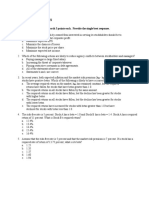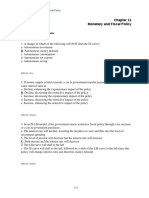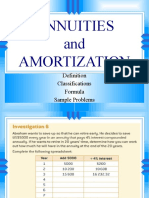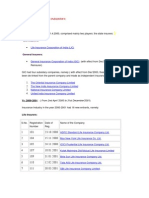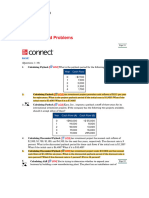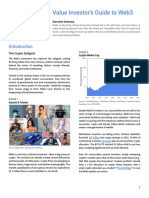Tutorial - 3
Tutorial - 3
Uploaded by
danrulz18Copyright:
Available Formats
Tutorial - 3
Tutorial - 3
Uploaded by
danrulz18Copyright
Available Formats
Share this document
Did you find this document useful?
Is this content inappropriate?
Copyright:
Available Formats
Tutorial - 3
Tutorial - 3
Uploaded by
danrulz18Copyright:
Available Formats
TUTORIAL 3 CHAPTER 5
MULTIPLE CHOICE QUESTIONS
1. Which of the following statements is true? a. Bond prices and interest rates move together. b. Coupon rates are fixed at the time of issue. c. Short-term securities have large price swings relative to long-term securities. d. The higher the coupon, the lower the price of a bond. Which of the following statements is true about bonds? a. The higher the coupon rate, the shorter the duration. b. The yield on a bond is usually fixed. c. A bond's coupon rate is equal to its face value. d. Most bonds pay interest annually. $5,000 invested at 6%, compounded quarterly, will be worth how much after 5 years? a. $6,691 b. $16,036 c. $6,734 d. $5,386 Tom deposits $10,000 in a savings deposit paying 4%, compounded monthly. What amount would he have at the end of seven years? a. $13,225 b. $13,159 c. $13,179 d. $13,325 Judy would like to accumulate $70,000 by the time her son starts college in ten years. What amount would she need to deposit now in a deposit account earning 6%, compounded yearly, to accumulate her savings goal? a. $4,200 b. $39,513 c. $39,088 d. $125,359 If a $1000 par value bond has an 8% coupon (annual payments) rate, a 4-year maturity, and similar bonds are yielding 11%, what is the price of the bond? a. $1,000.00 b. $880.22 c. $906.93 d. $910.35 A corporate bond, paying $65 interest at the end of each year for 6 years, has a face value of $1,000. If market rates on newly issued similarly rated corporate bonds are now 7.5%, what is the current market price of this bond? a. $953.06 b. $1,000.00 c. $1,048.41 d. $936.42 A $1000 bond with an 8.2% coupon rate, interest paid semiannually, and maturing in six years is currently yielding 7.6% in the market. What is the current price of the bond? a. $1,027.08 b. $1,131.19 c. $1,028.48 d. $972.00 A $1000 bond with a coupon rate of 7% matures in eight years. The bond is now selling for $950, what is the expected yield to maturity on the bond? a. 6.5% b. 7.9% c. 9.0% d. 8.3% A $1000 bond with a coupon rate of 10%, interest paid semiannually, matures in eight years and sells for $1120. What is the yield to maturity? a. 10.8% b. 11.0% c. 7.9% d. 7.6%
2.
3. 4.
5.
6.
7.
8.
9.
10.
11.
When a bond's coupon rate is equal to the market rate of interest, the bond will sell for
1
a. a discount. 12.
b. a premium.
c. par.
d. a variable rate.
A bond currently selling at a premium price above face value a. has a yield equal to its coupon rate. b. has a yield below its coupon rate. c. has a yield above its coupon rate. d. has no risk. If market interest rates fall after a bond is issued, the a. face value of the bond increases. b. investor will sell the bond. c. market value of the bond is increasing. d. market value of the bond is decreasing. Duration is a measure of a. a bond's price. b. a bond's contractual maturity. c. the length of time it takes to get back the original investment. d. bond price volatility. Bond A has a duration of 5.6 while bond B has a duration of 6.0. Bond B a. will have greater price variability, given a change in interest rates, relative to bond A. b. will have a longer maturity than bond A. c. will have a higher coupon rate than bond A. d. will have less price variability, given a change in interest rates, relative to bond A. A 3-year zero coupon bond selling at $900 and yielding 12.18 percent has a duration of a. 3 years. b. 2.78 years. c. 2.50 years. d. 2 years. A $1000 2-year 10% coupon bond is priced at $1000 in the market. The duration is a. less than two years. b. more than two years. c. 10%. years. d. 2
13.
14.
15.
16. 17.
18. 19.
The duration of a $1000, 2-year, 7% coupon bond (interest paid annually) is _____ when market rates are 8%? a. 2.036 b. 1.934 c. 1.902 d. 1.856 As bond maturity _________, so does the _________ and ________. a. decreases; coupon rate; market price. b. decreases; duration; face value. c. increases; duration; price variability. d. increases; risk; coupon rate. A $1,000 par, 8% Treasury bond maturing in three years is priced to yield 7%. price (assuming semiannual compounding) is a. $974.21 b. $813.50 c. $927.50 d. $1,026.64 Which of the following risks will not affect zero coupon bonds? a. price risk b. reinvestment risk c. credit risk d. default risk A bond yield measure should capture all of the following except a. coupon payments.
2
20.
Its market
21.
22.
b. c. d. 23.
reinvestment income. changing coupon rate levels. capital gains or losses.
The yield to maturity measure assumes that coupon interest is reinvested at a. the yield to maturity. b. the changing market rates. c. the coupon rate. d. the treasury bond rate. Calculate the realized return on a $1,000 face value, 9 percent coupon bond (annual) purchased for $800 and sold one year later for $850. a. 9% b. 11.25% c. 14.5% d. 17.5% Calculate the volatility of $1,000 face value 8% coupon bond whose price has varied from $1,020 to $1,050. a. $30.00 b. 5% c. 3% d. $50.00 Interest rate risk is a. duration. b. the extent that coupon rates vary with time. c. the potential variability in the realized rate of return caused by changes in market rates. d. the potential variability in the bond maturity caused by changing discount rates. Price risk and reinvestment risk a. offset one another to a certain extent as interest rates change. b. are two bond risks related to credit risk. c. work together to magnify the price impact of a change in interest rate. d. both have an effect on bond price. Reinvestment risk is the variability of return associated with a. the variability of bond maturities. b. the variability of bond coupon payments. c. the variability of rates of return on reinvested coupons. d. the variability of the market price on the bond. If a bond investor receives all the coupon payments on time and the face value on the contract maturity date, investor's return could still vary because of a. default risk b. price risk c. liquidity risk d. reinvestment risk. Two factors that affect interest rate risk are a. default risk and reinvestment risk. b. liquidity risk and reinvestment risk. c. price risk and political risk. d. price risk and reinvestment risk.
24.
25.
26.
27.
28.
29.
30.
31.
The sum of time weighted discounted cash flows divided by the price of the security is the a. volatility of the security. d. present value of the security cash flows. c. duration of the security. d. always greater than the maturity of the security.
3
32.
An increase in the supply of bonds in the bond market will a. be associated with a decrease in interest rates. b. always be matched by an increased demand for securities. c. be associated with an increase in bond interest rates. d. not affect interest rates, only security prices. All of the following are contractually fixed except a. par value b. yield c. maturity d. coupon
33.
ESSAY QUESTIONS 1. Name and discuss the variables that determine the price or value of a fixed-rate coupon bond.
2. Name and discuss the factors that must be considered when calculating the realized rate of return on a bond. 3. What are the relationships between bond price volatility and (a) bond maturity; (b) coupon rate?
4. Define and discuss interest rate risk. What are the two risk components of interest rate risk and how do these interact with each other? 5. What is bond duration and what are the implications of holding a bond to its duration versus holding the bond to maturity?
You might also like
- Marketing Strategies of DHL ExpressDocument11 pagesMarketing Strategies of DHL Expresslakshay100% (1)
- Chap 10 IM Common Stock ValuationDocument97 pagesChap 10 IM Common Stock ValuationHaziq Shoaib MirNo ratings yet
- Monetary and Fiscal Policy Skyveiw School QuizDocument32 pagesMonetary and Fiscal Policy Skyveiw School QuizHayleyblahblah100% (2)
- 7.4 Options - Pricing Model - Black ScholesDocument36 pages7.4 Options - Pricing Model - Black ScholesSiva SankarNo ratings yet
- Stock Valuation With Exercises IvanaDocument62 pagesStock Valuation With Exercises Ivanafrancis dungcaNo ratings yet
- Startup Financial ModelDocument102 pagesStartup Financial ModelAniket BardeNo ratings yet
- Local Voice - Winter 2019Document32 pagesLocal Voice - Winter 2019MoveUP, the Movement of United ProfessionalsNo ratings yet
- Answer-Introduction To FinanceDocument10 pagesAnswer-Introduction To FinanceNguyen Hong HanhNo ratings yet
- Tutorial Stocks - S2 - 2019.20Document3 pagesTutorial Stocks - S2 - 2019.20Leo ChristNo ratings yet
- Stock Price Grows at Dividend Growth RateDocument7 pagesStock Price Grows at Dividend Growth RateTalha FarooquiNo ratings yet
- ECN 104 Sample Problems CH 1-2Document11 pagesECN 104 Sample Problems CH 1-2y2k100No ratings yet
- ONAL Time Value of Money and Capital BudgetingDocument51 pagesONAL Time Value of Money and Capital BudgetingSUNMIN PARKNo ratings yet
- The Theory and Estimation of CostDocument23 pagesThe Theory and Estimation of CostFadi ChouNo ratings yet
- Module 1 ParagraphDocument13 pagesModule 1 Paragraphnurul habibah lubisNo ratings yet
- Chapter 7 OrganizingDocument30 pagesChapter 7 OrganizingaishahfarhahNo ratings yet
- Business Economics Course SyllabusDocument7 pagesBusiness Economics Course SyllabusDeva MgNo ratings yet
- Thinking Like An EconomistDocument44 pagesThinking Like An EconomistKothiya PriteshNo ratings yet
- The Investment Settings Chapter 1Document36 pagesThe Investment Settings Chapter 1tjsamiNo ratings yet
- Princ ch02 PresentationDocument41 pagesPrinc ch02 PresentationKhánh MaiNo ratings yet
- Problems On Bond YieldDocument3 pagesProblems On Bond YieldPersonal DocumentsNo ratings yet
- Answer FIN 401 Exam2 Fall15 V1Document7 pagesAnswer FIN 401 Exam2 Fall15 V1mahmudNo ratings yet
- Answer:: ch07: Dealing With Foreign ExchangeDocument10 pagesAnswer:: ch07: Dealing With Foreign ExchangeTong Yuen ShunNo ratings yet
- Parts of A ParagraphDocument1 pageParts of A Paragrapharman hossain100% (1)
- Homework Assignment - Week 2 - AnswersDocument11 pagesHomework Assignment - Week 2 - AnswersVoThienTrucNo ratings yet
- Chapter 4 - ElasticityDocument59 pagesChapter 4 - ElasticityHamdiNo ratings yet
- Chapter 10 - Aggregate Demand IDocument30 pagesChapter 10 - Aggregate Demand IwaysNo ratings yet
- Lecture Note - Chapter 12 - FamilyDocument55 pagesLecture Note - Chapter 12 - FamilyThùy Ngân VõNo ratings yet
- Conduct of Monetary Policy Goal and TargetsDocument12 pagesConduct of Monetary Policy Goal and TargetsSumra KhanNo ratings yet
- Specific Factors and Income Distribution: Eleventh Edition, Global EditionDocument69 pagesSpecific Factors and Income Distribution: Eleventh Edition, Global EditionBilge SavaşNo ratings yet
- Chapter 5 - Time Value of Money-Student VersionDocument8 pagesChapter 5 - Time Value of Money-Student Versionnamle999101No ratings yet
- Price Discrimination Under Monopoly: Types, Degrees and Other DetailsDocument18 pagesPrice Discrimination Under Monopoly: Types, Degrees and Other DetailsSanchit BabbarNo ratings yet
- Quantitative Problems Chapter 10Document5 pagesQuantitative Problems Chapter 10Nurainey Maraya100% (1)
- Sol 2Document10 pagesSol 2chikachiNo ratings yet
- Two Sectors, Three Sectors and Four Sector Model of National Income DeterminationDocument12 pagesTwo Sectors, Three Sectors and Four Sector Model of National Income Determinationsannu91No ratings yet
- Consumption Function and MultiplierDocument24 pagesConsumption Function and MultiplierVikku AgarwalNo ratings yet
- CHP 6 AnsDocument4 pagesCHP 6 AnsEvelyn Yee QinNo ratings yet
- Answer Key 1Document4 pagesAnswer Key 1Ben JohnsonNo ratings yet
- Practice Qns - Cap StructureDocument8 pagesPractice Qns - Cap StructureSadi0% (1)
- Lecture 3Document14 pagesLecture 3skye080No ratings yet
- MCQDocument34 pagesMCQshankarNo ratings yet
- Types of BondsDocument2 pagesTypes of Bondssnehachandan91No ratings yet
- FIM Exercise AnsDocument6 pagesFIM Exercise AnsSam MNo ratings yet
- Solutions To Chapter 5 Valuing BondsDocument8 pagesSolutions To Chapter 5 Valuing BondsCandace WagnerNo ratings yet
- Tradeoff Theory of Capital StructureDocument10 pagesTradeoff Theory of Capital StructureSyed Peer Muhammad ShahNo ratings yet
- Money Banking Practice Questions and AnswersDocument3 pagesMoney Banking Practice Questions and AnswersNihad RüstəmsoyNo ratings yet
- Health Economics 2013Document42 pagesHealth Economics 2013Syuraih AbdullahNo ratings yet
- 13 Valuation & Cost of Capital - NumericalsDocument32 pages13 Valuation & Cost of Capital - NumericalsGunjan PruthiNo ratings yet
- Balance of Payments:: Chapter Objectives & Lecture Notes FINA 5500Document27 pagesBalance of Payments:: Chapter Objectives & Lecture Notes FINA 5500Anonymous H0SJWZE8100% (1)
- Bonds and Their ValuationDocument36 pagesBonds and Their ValuationRubab BabarNo ratings yet
- Multiple Choice Questions: Monetary and Fiscal PolicyDocument17 pagesMultiple Choice Questions: Monetary and Fiscal PolicyrohanNo ratings yet
- HUM 2107: Engineering Economics: Fiscal and Monetary PolicyDocument10 pagesHUM 2107: Engineering Economics: Fiscal and Monetary PolicyAshrafi ChistyNo ratings yet
- Lecture (Monetary Theory & Policy)Document12 pagesLecture (Monetary Theory & Policy)simraNo ratings yet
- Part II Interest Rates and TVM (Revised For 2e)Document68 pagesPart II Interest Rates and TVM (Revised For 2e)Harun MusaNo ratings yet
- Chapter 2: Determination of Interest RatesDocument37 pagesChapter 2: Determination of Interest RatesDương Nguyễn TùngNo ratings yet
- Annuities and Amortization: Classifications Formula Sample ProblemsDocument27 pagesAnnuities and Amortization: Classifications Formula Sample ProblemsMr.Clown 107No ratings yet
- Bond ValuationDocument29 pagesBond ValuationNur Al AhadNo ratings yet
- EBT Market: Bonds-Types and CharacteristicsDocument25 pagesEBT Market: Bonds-Types and CharacteristicsKristen HicksNo ratings yet
- SpecificFactorsModel LectureSlidesDocument66 pagesSpecificFactorsModel LectureSlidestohox86894No ratings yet
- Topic 6 Two Variable Regression Analysis Interval Estimation and Hypothesis TestingDocument36 pagesTopic 6 Two Variable Regression Analysis Interval Estimation and Hypothesis TestingOliver Tate-DuncanNo ratings yet
- Bond Valuation ProblemsDocument2 pagesBond Valuation ProblemsChloeNo ratings yet
- Ch08 ShowDocument47 pagesCh08 ShowAri ApriantoNo ratings yet
- CH 05Document13 pagesCH 05Mahmoud HamedNo ratings yet
- Wallstreetjournaleurope 20151224 The Wall Street Journal EuropeDocument20 pagesWallstreetjournaleurope 20151224 The Wall Street Journal EuropestefanoNo ratings yet
- Portfolio Management in Kotak SecuritesDocument92 pagesPortfolio Management in Kotak SecuritesGunda Abhishek0% (1)
- DeloitteTechTrends-2018 FINAL PDFDocument164 pagesDeloitteTechTrends-2018 FINAL PDFjosephchaines100% (1)
- The Secret IRS Files - Trove of Never-Before-Seen Records Reveal How The Wealthiest Avoid Income Tax - ProPublicaDocument25 pagesThe Secret IRS Files - Trove of Never-Before-Seen Records Reveal How The Wealthiest Avoid Income Tax - ProPublicaDouglas PierreNo ratings yet
- Markel LongDocument2 pagesMarkel LongAlexander HertzbergNo ratings yet
- 02 Strategy FormulationDocument69 pages02 Strategy Formulationtheanuuradha1993gmai100% (1)
- Indian History of InsuranceDocument6 pagesIndian History of InsuranceJeyarajasekar TtrNo ratings yet
- Accolet - Synopsys On India Budget 2022Document26 pagesAccolet - Synopsys On India Budget 2022umesh hivreNo ratings yet
- Handout 5 - 6 - Review Exercises - Questions in TextDocument6 pagesHandout 5 - 6 - Review Exercises - Questions in Text6kb4nm24vjNo ratings yet
- Private Annuity SSRN-Id1503462Document159 pagesPrivate Annuity SSRN-Id1503462Partnership Tax Magazine; David Greenberg PhD, MSA, EA, CPA; Tax Group International; 646-705-2910No ratings yet
- Environmental AccountingDocument12 pagesEnvironmental AccountingValentinaNo ratings yet
- Sparkline Web3Document16 pagesSparkline Web3Joaquin TreeversifeNo ratings yet
- Techno Funda Pick Techno Funda Pick: R Hal Research AnalystsDocument10 pagesTechno Funda Pick Techno Funda Pick: R Hal Research AnalystsRajasekhar Reddy AnekalluNo ratings yet
- Kahoot!Document6 pagesKahoot!Federico NiciferoNo ratings yet
- Sample ProposalDocument19 pagesSample Proposalabhisheksherkar7717No ratings yet
- 0452 s06 QP 3 PDFDocument24 pages0452 s06 QP 3 PDFcheah_chinNo ratings yet
- Indian Economy and FeaturesDocument36 pagesIndian Economy and FeaturesAllahabadi YaduvanshiNo ratings yet
- Partnership and Corporation Solman 2011 Chapter 1Document7 pagesPartnership and Corporation Solman 2011 Chapter 1Reymilyn Sanchez0% (1)
- Other Comprehensive Income OciDocument5 pagesOther Comprehensive Income OciGenesis Anne MagsicoNo ratings yet
- Industrial ParksDocument30 pagesIndustrial ParksSubham DahalNo ratings yet
- Colgate-Palmolive (India) LimitedDocument15 pagesColgate-Palmolive (India) LimitedAditya GawdeNo ratings yet
- AFM WB CH 8 ActivitiesDocument15 pagesAFM WB CH 8 ActivitiesShamail Afroz SaudagarNo ratings yet
- Entrepreneurship and Innovation Management: Welcome To Mbs673Document30 pagesEntrepreneurship and Innovation Management: Welcome To Mbs673KENNEDYNo ratings yet
- t7 Borrowing CostDocument3 pagest7 Borrowing CostShirley VunNo ratings yet
- Exercise - Mission Statement AnalysisDocument1 pageExercise - Mission Statement AnalysisFazlin GhazaliNo ratings yet





































